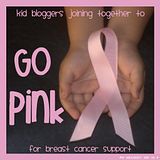 |
| Tonya Valentine on Pink Ribbons |

Breast Cancer is second only to lung cancer as the leading cause of cancer death among women in the United States. Join some Kid Bloggers in our GO PINK BLOG HOP to increase prevention and awareness. This post is in loving memory of my mother-in-law, Joan Case, who lost her fight with breast cancer. And also to my sister, Diane Atkinson, who is a breast cancer survivor of seven years! The following Prevention Tips are taken from Breast Cancer Awareness.com.
 |
| Diane, me & Sarah |
PREVENTION TIPS:
- Hormonal Factors: Consult your physician to be aware if you are at greater risk due to prescriptions or stage of life.
- Diet and Lifestyle: Studies show that in populations that consume a high-fat diet, women are more likely to die of breast cancer than women in populations that consume a low-fat diet. It is not known if a diet low in fat will prevent breast cancer. Eating a diet rich in beta-carotene may decrease the risk of breast cancer. Exercise, especially in young women, may decrease hormone levels and contribute to a decreased breast cancer risk. Breast feeding may also decrease a woman's risk of breast cancer. Postmenopausal weight gain, especially after natural menopause and/or after age 60, may increase breast cancer risk.
- Alcohol: Drinking alcohol may be linked to increased breast cancer risk. The more alcohol a woman drinks, the more the risk of breast cancer may increase, compared to a woman who drinks no alcohol. In addition, a diet rich in beta-carotene, folate, and vitamins A and C may reverse the higher risk of breast cancer linked to alcohol use.
- Radiation: Studies have shown that reducing the number of chest x-rays, especially at a young age, decreases the risk of breast cancer.
- Genetics: Women who inherit specific genes are at a greater risk for developing breast cancer. Research is underway to develop methods of identifying high-risk genes.

Visit The Pink Ribbon!
Breast Cancer AWARENESS Tips are quoted from the National Cancer Institute:
"What are NCI´s recommendations for screening mammograms?
- Women age 40 and older should have mammograms every 1 to 2 years.
- Women who are at higher than average risk of breast cancer (for example, because of a family history of the disease or because they carry a known mutation in either the BRCA1 or the BRCA2 gene) should talk with their health care providers about whether to have mammograms before age 40 and how often to have them.
What is the best method of detecting breast cancer as early as possible?
- Getting a high-quality screening mammogram and having a clinical breast exam (an exam done by a health care provider) on a regular basis are the most effective ways to detect breast cancer early. As with any screening test, screening mammograms have both benefits and limitations. For example, some cancers cannot be detected by a screening mammogram but may be found by a clinical breast exam.
- Checking one’s own breasts for lumps or other unusual changes is called a breast self-exam, or BSE. This type of exam cannot replace regular screening mammograms or clinical breast exams. In clinical trials, BSE alone was not found to help reduce the number of deaths from breast cancer.
- Although regular BSE is not specifically recommended for breast cancer screening, many women choose to examine their own breasts. Women who do so should remember that breast changes can occur because of pregnancy, aging, menopause, during menstrual cycles, or when taking birth control pills or other hormones. It is normal for breasts to feel a little lumpy and uneven. Also, it is common for breasts to be swollen and tender right before or during a menstrual period. If a woman notices any unusual changes in her breasts, she should contact her health care provider. "
- National Breast Cancer Foundation
- National Cancer Institute
- Breast Cancer Awareness.com
- Susan G. Koman – Race for the Cure
I'm guest posting today at Crayon
Freckles - In Her Shoes. Hope you'll visit her amazing blog. You might be interested in my post Moms Need Pampering Time Too - or in my books: Kindergarten: Tattle-Tales, Tools, Tactics, Triumphs and Tasty Treats for Teachers and Parents or co-written with Katie Norris - The Happy Mommy Handbook: The Ultimate How-to Guide on Keeping Your Toddlers and Preschoolers Busy, Out of Trouble and Motivated to Learn. Both have been number 1 bestsellers on Amazon.
Prevention resources would you like to add?
Or do you have a story to share?
- The Educators’ Spin On It
- RainbowsWithinReach
- Projects for Preschoolers
- Raising Figure Skaters
- Kindergarten & Preschool for Parents & Teachers
- Home Learning Journey
- Go Kid Yourself
- Frogs & Snails & Puppy Dog Tails
- Mama Smiles

If you and/or your children are doing something to help raise awareness for breast cancer, feel free to link below!

I didn't know the X-ray link, although it isn't surprising. I had SO many of those as a toddler/young child because it was the only way they had (at the time) of tracking how well my own cancer treatment was working. I pinned this to my "social good" board.
ReplyDeleteMaryanne - so glad you are a survivor. Love your blog and all that you do to promote cancer prevention and cures.
ReplyDeleteYour tips and resources are wonderful. Thank you so much for sharing with this effort.
ReplyDeleteWe need to realize that women and lots of women have and can get breast cancer. We all need to have breast cancer awareness and see what we can do to help prevent it and work better with it. This was a great information!
ReplyDeleteThis is awesome. What a great party you have going on. Thanks for linking up to tip-toe thru tuesday.
ReplyDeleteThanks for posting such a relevant and informative post!
ReplyDelete